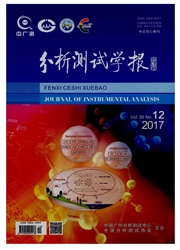

 中文摘要:
中文摘要:
利用紫外-可见吸收和荧光光谱法研究了血红蛋白(Hb)与细胞色素c(Cytc)两种血红素蛋白的去折叠行为。采用化学变性剂盐酸胍(GdHCl)和尿素(Urea)诱导两种蛋白构象去折叠,阐述了两种蛋白的去折叠机理。Hb的血红素(Heme)辅基通过与卟啉铁原子和组氨酸配位,与肽链键合的稳定性较差,在3.0 mol/L的盐酸胍作用下即发生解离。而Cyt c的Heme辅基通过卟啉与半胱氨酸形成二硫键呈现较强的稳定性,盐酸胍浓度达到6.0 mol/L也难使其发生解离。该研究为阐释蛋白构象与功能之间的关系提供了重要依据。
 英文摘要:
英文摘要:
The unfolding processes of two hemoproteins including hemoglobin( Hb) and cytochrome c( Cytc) were investigated by using UV-Vis absorption and fluorescence emission spectrometry. The unfolding behaviors of Hb and Cyt c were induced with two chemical denaturing agents of guanidine hydrochloride( Gd HCl) and urea. Weak bonding energy between heme groups and the histidine on Hb peptide caused the poor stability of heme groups and their easier dissociation from the peptide of Hb only in 3. 0 mol / L GdHCl. However,high bonding force due to the disulfide bond between heme group and cysteines on Cyt c peptide chain increased the stability of Cytc. Heme group did not dissociate from Cytc peptide with high concentration of 6. 0 mol / L GdHCl. The research provides an important basis for the elaboration of relationship between protein functions and their conformations.
 同期刊论文项目
同期刊论文项目
 同项目期刊论文
同项目期刊论文
 Effects of Cu2+ and pH on the binding of alizarin red S to bovine serum albumin based on the analysi
Effects of Cu2+ and pH on the binding of alizarin red S to bovine serum albumin based on the analysi Construction of a Zinc Porphyrin-fullerene Derivative Based Non-enzymatic Electrochemical Sensor for
Construction of a Zinc Porphyrin-fullerene Derivative Based Non-enzymatic Electrochemical Sensor for Amperometric immunosensor based on covalent immobilization of new methylene blue and penicillin poly
Amperometric immunosensor based on covalent immobilization of new methylene blue and penicillin poly 期刊信息
期刊信息
